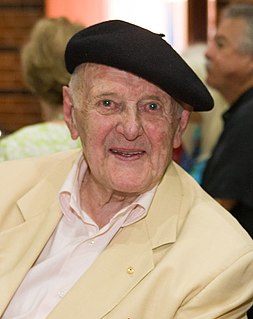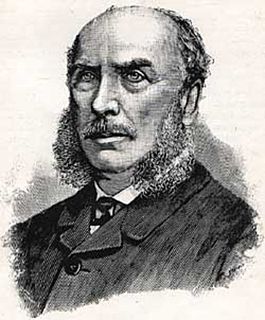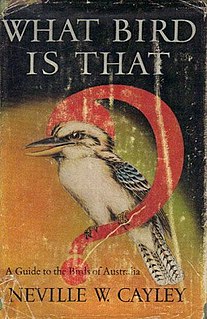
John Gould was an English ornithologist. He published a number of monographs on birds, illustrated by plates produced by his wife, Elizabeth Gould, and several other artists, including Edward Lear, Henry Constantine Richter, Joseph Wolf and William Matthew Hart. He has been considered the father of bird study in Australia and the Gould League in Australia is named after him. His identification of the birds now nicknamed "Darwin's finches" played a role in the inception of Darwin's theory of evolution by natural selection. Gould's work is referenced in Charles Darwin's book, On the Origin of Species.
Gregory Macalister Mathews CBE FRSE FZS FLS was an Australian-born amateur ornithologist who spent most of his later life in England.

William Beckwith McInnes was an Australian portrait painter, winner of the Archibald Prize seven times for his traditional style paintings. He was an instructor and acting-director at the National Gallery of Victoria.

Tom Iredale was an English-born ornithologist and malacologist who had a long association with Australia, where he lived for most of his life. He was an autodidact who never went to university and lacked formal training. This was reflected in his later work; he never revised his manuscripts and never used a typewriter.

John Gilbert was an English naturalist and explorer. Gilbert is often cited in the earliest descriptions of many Australian animals, many of which were unrecorded in European literature, and some of these are named for him by those authors. Gilbert was sent to the newly founded Swan River Colony and made collections and notes on the unique birds and mammals of the surrounding region. He later joined expeditions to remote parts the country, continuing to make records and collections until he was killed during a violent altercation at Mitchell River (Queensland) on the Cape York Peninsula.

The Royal Australasian Ornithologists Union (RAOU), now part of BirdLife Australia, was Australia's largest non-government, non-profit, bird conservation organisation. It was founded in 1901 to promote the study and conservation of the native bird species of Australia and adjacent regions, making it Australia's oldest national birding association. In 1996, the organisation adopted the trading name of Birds Australia for most public purposes, while retaining its original name for legal purposes and as the publisher of its journal, the Emu. In 2012, the RAOU merged with Bird Observation & Conservation Australia to form BirdLife Australia.
The Gould League is an independent Australian organisation promoting environmental education, founded in Victoria in 1909 and named after the English ornithologist John Gould. Largely autonomous branches were subsequently established in other Australian states.

John Henry Olsen, AO, OBE is an Australian artist and winner of the 2005 Archibald Prize. Olsen's primary subject of work is landscape.

Tamarama is a beachside suburb, eastern suburb of Sydney, in the state of New South Wales, Australia. Tamarama is 6 kilometres east of the Sydney central business district, in the local government area of Waverley Council.
John William Lewin was an English-born artist active in Australia from 1800. The first professional artist of the colony of New South Wales, he illustrated the earliest volumes of Australian natural history. Many of his illustrations were of native Australian birds on native Australian plants.

Robert David FitzGerald was an Irish-Australian surveyor, ornithologist, botanist and poet.

John Albert Leach was an ornithologist, teacher and headmaster in the state of Victoria, Australia.
Alexander Hugh Chisholm OBE FRZS also known as Alec Chisholm, was a noted Australian naturalist, journalist, newspaper editor, author and ornithologist. He was a member of the Royal Australasian Ornithologists Union (RAOU), President of the RAOU 1939–1940, and editor of its journal the Emu from 1926 to 1928. In 1941 he was elected a Fellow of the RAOU in 1941 and the previous year he had been the first recipient of the Australian Natural History Medallion for his work in ornithology and popularising natural history. Chisholm was a prolific and popular writer of articles and books, mainly on birds and nature but also on history, literature and biography.

Henry Luke White was a wealthy grazier, and a keen philatelist, book collector, amateur ornithologist and oölogist of Scone, New South Wales, Australia.
Harold James Frith AO was an Australian administrator and ornithologist. He was born at Kyogle, New South Wales and studied Agricultural Science at Sydney University. Harry Frith first joined the CSIRO Division of Plant Industry but later transferred to the Division of Wildlife and carried out extensive research on malleefowl, waterfowl, especially magpie geese, and pigeons. He eventually became Chief of the Division and was instrumental in proposals that led to the establishment of Kakadu National Park.
The NSW Field Ornithologists Club, also known as Birding NSW, was founded on 21 July 1970 when activities associated with the Royal Australasian Ornithologists Union (RAOU) in New South Wales ceased following drastic reform within the RAOU in the late 1960s which abolished all its branches. Birding NSW publishes a bi-monthly newsletter and holds regular meetings in Sydney and Tuggerah as well as regular field excursions and campouts. The logo of Birding NSW is the azure kingfisher.
Neville Cayley may refer to:

Neville Henry Peniston Cayley was an Australian painter who contributed greatly to public awareness of Australian birds through his meticulous and attractive watercolours of iconic species.

What Bird Is That? A Guide to the Birds of Australia is a book first published in 1931 by Angus & Robertson in Sydney. Authored and illustrated by Neville William Cayley, it was Australia's first fully illustrated national field guide to birds, a function it served alone for nearly 40 years. In 1960 it was rated the all-time best seller in Australian natural history.
Lancelot Eric Richdale was a New Zealand teacher and amateur ornithologist.













